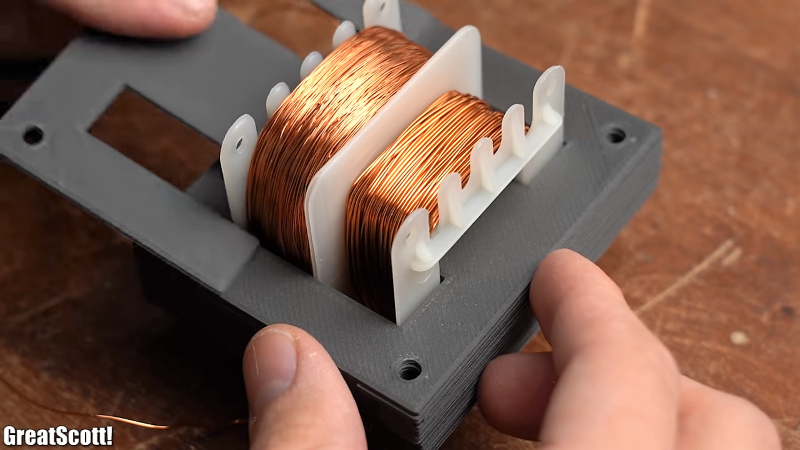Transformers are deceptively simple devices. Just coils of wire sharing a common core, they tempt you into thinking you can make your own, and in many cases you can. But DIY transformers have their limits, as [Great Scott!] learned when he tried to 3D-print his own power transformer.
To be fair, the bulk of the video below has nothing to do with 3D-printing of transformer coils. The first part concentrates on building transformer cores up from scratch with commercially available punched steel laminations, in much the same way that manufacturers do it. Going through that exercise and the calculations it requires is a great intro to transformer design, and worth the price of admission alone. With the proper number of turns wound onto a bobbin, the laminated E and I pieces were woven together into a core, and the resulting transformer worked pretty much as expected.
The 3D-printed core was another story, though. [Great Scott!] printed E and I pieces from the same iron-infused PLA filament that he used when he 3D-printed a brushless DC motor. The laminations had nowhere near the magnetic flux density of the commercial stampings, though, completely changing the characteristics of the transformer. His conclusion is that a printed transformer isn’t possible, at least not at 50-Hz mains frequency. Printed cores might have a place at RF frequencies, though.
In the end, it wasn’t too surprising a result, but the video is a great intro to transformer design. And we always appreciate the “DIY or Buy” style videos that [Great Scott!] does, like his home-brew DC inverter or build vs. buy lithium-ion battery packs.
















It seems the irony was lost on Great Scott.
:’D
Because it wasn’t irony enough?
The endless quest to find the worst application for a 3d printer
My gold standard is still the unappetizing promise of printed food products.
Can’t have bananas today, the yellow cartridge is empty
You do know there are working 3D donut printers that work, right?
I find this an interesting experiment that actually yeilds useful unexpected info.
Still a few wrinkles to iron out. Perhaps upgrade to one of those sintered metal 3D printers.
Iron out?
The issue is that he needed to put more iron in. :)
No point of printing individual fake E, I sheets as there isn’t going to be any eddy current in the non-conductive material.
Imitating form not function without understanding of the basics.
Even if you filled the gaps with solid material, the distributed air gap would still mean there’s little magnetic flux going around. It would still only work at high frequencies.
But speaking of high frequencies, powdered iron and ferrite toroids for winding inductors and baluns are ridiculously overpriced…
” Printed cores might have a place at RF frequencies, though”
Thankyou for that one line!
High frequency Transformer design is my intended target, so where do you get nanocrystalline filament for your average 3D printer??